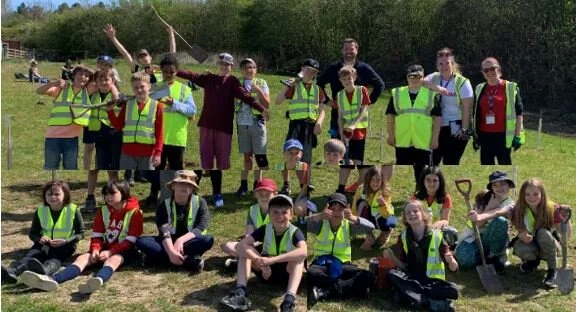When Grow Batheaston rescued 40 oak trees from the Oakupy project (https://bristolgreencapital.org/rescue-saplings-mulcher-arkbounds-oakupy-project/) that were due to be destroyed we wondered where on earth we would find the space to plant them!? After a number were adopted by residents with sufficient land we had 30 saplings remaining. After a conversation with Councillor Kevin Guy he suggested planting some on the meadows next to New Leaf Farm and thought it would be a good idea to give some of the the children from the local Primary school the chance to get involved. It seemed the logical choice would be Oak class (year 6), they jumped at the chance, and every pupil was able to each plant their very own oak sapling on a very sunny afternoon in April.
Oak class planting oak trees with New Leaf Farm in the background
Here some of the children recount their experience:
On Friday we walked over the New Leaf Farm to plant some Oak trees, everyone was very excited and was looking forward to the day. When we got there, we were greeted by a guy called Kevin. He told us each to pick small tree and walk down a path to a corner of a field. He showed us how to dig the holes and place the trees in carefully. Everyone thought it looked really easy, but when it came to us digging the holes, we found out it wasn’t as easy as we thought. An adult came to help us, as the ground was quite tough. After the grown-ups finished with the hard work; we got some bonemeal to put it in the deep holes to make them grow better. Then planted the trees and covered up the roots so if the sun got to them, they wouldn't burn in the heat. Now all we needed to do was push a short bamboo stick into the ground to help the trees stay straight. After that, we rapped a plastic case around the tree and stick in case the rabbits try to dig it up. We all enjoyed the day, and it was a good experience to show how to help our community and planet, I would definitely do it again.
By Emily
On Friday 23rd April, Oak class went to New Leaf Farm to plant over twenty-five oak tree saplings. The trip included a short trip from Batheaston to Bathampton, then to New Leaf Farm. Once there, Oak Class chose their saplings and went to a nearby field to plant them. It took less than 1 hour to dig about thirty holes, fill them with bonemeal to assist growth, put the saplings in the holes, water the plants so they are hydrated, and put a plant protector over the top to keep it safe from all sorts of wild animals. The whole experience was incredibly fun and enjoyable.
By Josh
We all went to New Leaf farm to plant oak trees.
We planted oak trees to help the environment and to help all the trees that got chopped down. It was very fun digging holes and planting trees we even found some insects. When I finished burying and flattening, I helped different people with their plants.
After we finished someone got a lump of grass and put it in their pot and threw it into other persons pot, so it went from pot to pot in a loop. The people at the farm were very nice, so nice they let us keep pots and some of us put the pot on our head. Before we planted our trees, we named them. I called mine, macaroni.
By Sam
Oak class with Councillor Kevin Guy
Approximately 30 trees were planted, the ground was indeed very hard and dry from the lack of rain and needed a mattock and a bit of muscle from GB team member Toby Gascoigne to start off the holes. Once the holes had been dug, each one was given a sprinkle of magic dust! (A combination of bonemeal and root grow professional, which is a blend of pure mycorrhizal fungi that is specially developed to rapidly colonise the roots whenever new plants or trees are going to ground). Once the trees were added and the holes filled, we then staked them, added rabbit guards and watered them in.
Tree planting - team work
The planting of these oaks is in line with the Grow Batheaston’s aim to encourage biodiversity.
According to the woodland trust ‘Oak forests support more life forms than any other native forest. They are host to hundreds of insect species, supplying many birds with an important food source. In autumn, mammals such as squirrels, badgers and deer feed on acorns.
Flower and leaf buds of English oak are the food plants of the caterpillars of purple hairstreak butterflies.
The soft leaves of English oaks break down with ease in autumn and form a rich leaf mould beneath the tree, supporting invertebrates such as the stag beetle, and fungi, like the oakbug milkcap. Holes and crevices in the tree bark are perfect nesting spots for the pied flycatcher, redstart or marsh tit.
Bats also roost in old woodpecker holes or under loose bark, as well as feeding on the rich supply of insects in the tree canopy.
Oak class wearing the plant pots!
They aren't just sources of food, medicines and materials. The carbon-locking qualities of trees and woods are crucial in the fight against climate change.
We very much look forward to seeing the Oak trees grow and develop and hope that the children of Oak class that planted these trees will come back with their children and grandchildren in years to come. Anyone can see them on the path that goes through the meadows past New Leaf Farm, why not go and take a look?




